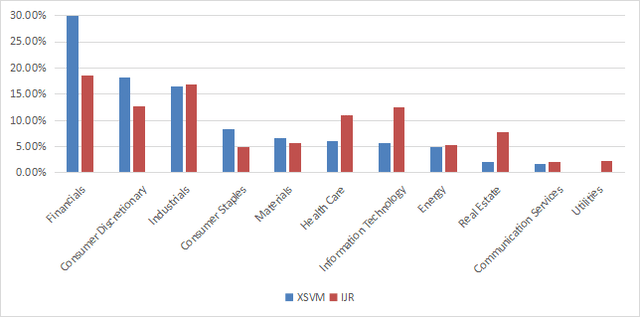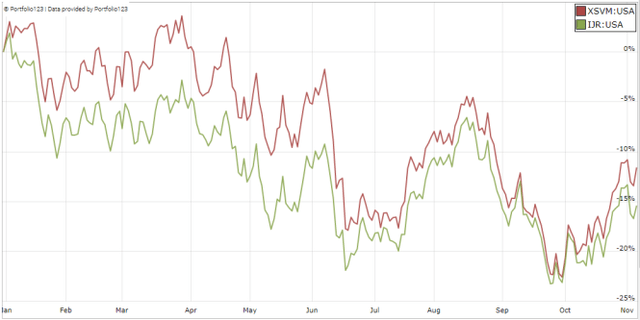takasuu
Strategy and portfolio
The Invesco S&P SmallCap Value with Momentum ETF (NYSEARCA:XSVM) has been tracking the S&P 600 High Momentum Value Index since 03/03/2005. It has 120 holdings, a distribution yield of 1.87% and an expense ratio of 0.36%. Distributions are paid quarterly.
As described in the prospectus by Invesco, stocks in the parent index S&P 600 are given a value score based on three ratios: book-value-to-price, earnings-to-price, and sales-to-price. Then, a momentum score is given to the 240 stocks with the highest value score. It is calculated from the 12-month return excluding the most recent month. The 120 stocks with the highest momentum score are included in the S&P 600 High Momentum Value Index and weighted by value score. The index and ETF holdings are reconstituted and rebalanced twice a year.
The portfolio is almost exclusively invested in U.S. -based companies (98% of asset value). The heaviest sector is financials (30%), followed by consumer discretionary (18.2%) and industrials (16.4%). Other sectors are under 9%. Compared to the parent index S&P 600, tracked by the iShares Core S&P Small-Cap ETF (IJR), XSVM overweights significantly financials, consumer discretionary and consumer staples. It underweights healthcare, technology, real estate and ignores utilities.
XSVM sectors ( chart: author; data: Fidelity)
Aggregate valuation ratios are much cheaper than for the parent index, as expected from a value ETF (see next table). The difference in price/sales is especially impressive. However, these metrics are biased by the heavy weight of the financial sector, where they are naturally lower, and also less reliable.
|
XSVM |
IJR |
|
|
Price/Earnings TTM |
6.6 |
11.61 |
|
Price/Book |
1.08 |
1.69 |
|
Price/Sales |
0.32 |
0.86 |
|
Price/Cash Flow |
5.23 |
9.13 |
Source: Fidelity
The top 10 holdings represent 16.2% of the portfolio value. The next table lists their weights and valuation ratios. The largest holding is below 3%, so risks related to individual companies are low.
|
Ticker |
Name |
Weight% |
P/E ttm |
P/E fwd |
P/Sales |
P/Book |
P/FCF |
Yield |
|
Cross Country Healthcare, Inc. |
2.59 |
5.40 |
6.52 |
0.43 |
2.88 |
22.86 |
0 |
|
|
Atlas Air Worldwide Holdings, Inc. |
2.08 |
8.11 |
6.80 |
0.76 |
1.17 |
14.96 |
0 |
|
|
Olympic Steel, Inc. |
1.57 |
3.00 |
3.91 |
0.13 |
0.66 |
N/A |
1.24 |
|
|
StoneX Group, Inc. |
1.52 |
11.76 |
9.72 |
0.03 |
1.78 |
6.84 |
0 |
|
|
Fresh Del Monte Produce, Inc. |
1.51 |
19.06 |
18.82 |
0.30 |
0.70 |
425.20 |
2.18 |
|
|
Conn’s, Inc. |
1.43 |
6.77 |
N/A |
0.13 |
0.34 |
3.39 |
0 |
|
|
The GEO Group, Inc. |
1.42 |
16.84 |
6.76 |
0.47 |
1.02 |
5.80 |
0 |
|
|
EZCORP, Inc. |
1.38 |
16.77 |
13.92 |
0.90 |
1.11 |
21.82 |
0 |
|
|
The Andersons, Inc. |
1.37 |
8.49 |
10.59 |
0.08 |
1.08 |
N/A |
1.93 |
|
|
SpartanNash Co. |
1.35 |
21.10 |
15.47 |
0.14 |
1.63 |
1517.32 |
2.34 |
Weights: Invesco; Ratios: Portfolio123
Historical performance
Since inception, XSVM has slightly underperformed IJR. However, the difference in annualized return is not significant (25 bps). It is also a little bit more risky regarding drawdown and volatility (standard deviation of monthly returns).
|
since inception |
Total Return |
Annual Return |
Drawdown |
Sharpe ratio |
Volatility |
|
XSVM |
322.68% |
8.50% |
-61.61% |
0.43 |
22.93% |
|
IJR |
340.27% |
8.75% |
-59.77% |
0.47 |
20.42% |
Data calculated with Portfolio123
As of writing, XSVM beats IJR by about 4 percentage points in 2022.
XSVM vs. IJR in 2022 to date (Portfolio123)
Comparison with my Dashboard List model
The Dashboard List is a list of 80 stocks in the S&P 1500 index, updated every month based on a simple quantitative methodology. All stocks in the Dashboard List are cheaper than their respective industry median in Price/Earnings, Price/Sales and Price/Free Cash Flow. After this filter, the 10 companies with the highest Return on Equity in every sector are kept in the list. Some sectors are grouped together: energy with materials, communication with technology. Real estate is excluded because these valuation metrics don’t work well in this sector. I have been updating the Dashboard List every month on Seeking Alpha since December 2015, first in free-access articles, then in Quantitative Risk & Value.
The next table compares XSVM performance since inception with the Dashboard List model, with a tweak: the list is reconstituted twice a year like XSVM underlying index.
|
since inception |
Total Return |
Annual Return |
Drawdown |
Sharpe ratio |
Volatility |
|
XSVM |
322.68% |
8.50% |
-61.61% |
0.43 |
22.93% |
|
Dashboard List |
401.64% |
9.56% |
-57.58% |
0.53 |
18.82% |
Past performance is not a guarantee of future returns. Data Source: Portfolio123
The Dashboard List slightly outperforms XSVM and shows a lower risk measured in drawdown and volatility. However, the ETF performance is real and the model simulation is hypothetical.
Price to Book: a risky concept of value
I like the idea of mixing various ratios to rank value stocks like XSVM does. However, the underlying index has two shortcomings in my opinion. The first one is to classify all stocks on the same criteria. It means the valuation ratios are considered comparable across sectors. Obviously they are not: you can read my monthly dashboard here for more details about this topic. A consequence is to overweight sectors where valuation ratios are naturally cheaper, especially financials. Sectors with large intangible assets like technology are disadvantaged. Companies with large intangible assets are those with a business model based on massive R&D, or a strong branding, or large user databases, or operating in a field where competition is limited by an expensive entry ticket. All these elements are not correctly reflected by valuation ratios.
The second shortcoming comes from the price/book ratio (P/B), which adds some risk in the strategy. Speaking probabilities, a large group of companies with low P/B contains a higher percentage of value traps than a same-size group with low price/earnings, price/sales or price/free cash flow. Statistically, such a group will also have a higher volatility and deeper drawdowns in price. The next table shows the return and risk metrics of the cheapest quarter of the S&P 500 (i.e.125 stocks) measured in price/book, price/earnings, price/sales and price/free cash flow. The sets are reconstituted annually between 1/1/1999 and 1/1/2022 with elements in equal weight.
|
Annual Return |
Drawdown |
Sharpe ratio |
Volatility |
|
|
Cheapest quarter in P/B |
9.95% |
-72.36% |
0.48 |
21.05% |
|
Cheapest quarter in P/E |
11.25% |
-65.09% |
0.57 |
18.91% |
|
Cheapest quarter in P/S |
12.62% |
-65.66% |
0.6 |
20.46% |
|
Cheapest quarter in P/FCF |
12.23% |
-63.55% |
0.61 |
19.05% |
Data calculated with Portfolio123
This also explains my choice of not using P/B in my Dashboard List model (more info at the end of this post).
Takeaway
XSVM is a small-cap ETF combining valuation ratios with a 12-month momentum score in its stock screening process. The financial sector represents 30% of asset value. It is slightly behind its parent index S&P 600 in total return since its inception in March 2005. It may bring some value in a tactical allocation strategy switching between growth and value styles. However, it has failed at bringing excess return or risk reduction relative to its parent index as a buy-and-hold investment, despite a higher expense ratio. In my opinion, there are two flaws in its strategy: it ranks stocks regardless of their sectors, and using price/book as a primary factor increases the risk of catching value traps. An efficient value model should compare stocks in comparable sets (sector, industry), like I do in the Dashboard List since 2015. This model also uses three valuation metrics, excluding price/book. Moreover, a simple ROE rule helps filter out some value traps and normalize the number of components.


Be the first to comment